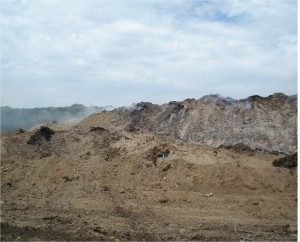On Sunday around 10 pm, fire broke out in the vegetation waste storage / crushing zone (composting station, located near a former locker) at a burial site for non-hazardous waste. Since first responders were unable to access the site, the town’s mayor made himself available to unlock the gate. Fire-fighters decided to let the fire burn itself out without taking action until Monday morning. Returning to the scene at 6 am the next morning, they again elected to allow the waste to burn on its own without any direct intervention (sprinkling, smothering) to avoid worsening the situation. The facility operator, who was only informed on Monday by lorry drivers with a company that had seen the flames from the road, arrived on-site at 6:30 am. Using backhoe loaders, a 1.5 m-high earthen wall was built around the damaged storage zone; next, the wall and surrounding areas were sprinkled via a 5-m3 mobile tanker in order to avoid spreading of the blaze. As a precaution, the operator moved more than 200 m³ of vegetation debris at the end of the morning; also, 7 biogas wells were closed and the vicinity cleared of undergrowth. Over 3,500 tonnes of vegetation waste had already burned. This combustion continued for at least 10 consecutive days, generating noticeable smoke and odours across adjacent municipalities. To eliminate these nuisances, the public authority owning the site ordered the operator to cover with earth the entire waste zone one week after the initial outbreak. Regular monitoring rounds were conducted for several weeks. The authority issued press releases to the local media and updated information on its website for neighbours to stay abreast of the situation and organise site visits for local associations.
Three hypotheses were forwarded: self-combustion, malicious act, or lightning strike. The fact of no lightning strike on the day of the accident and no visible signs of a break-in led to the conclusion of self-heating among crushed vegetation debris, facilitated by stormy conditions: a rainfall event during the afternoon along with strong winds. The notification procedure between the town hall, emergency services and the operator was revised (response sheets listing phone numbers to call); vegetation waste storage was reorganised into distinct swaths; and the waste crushing frequency was increased (at least once a month).




